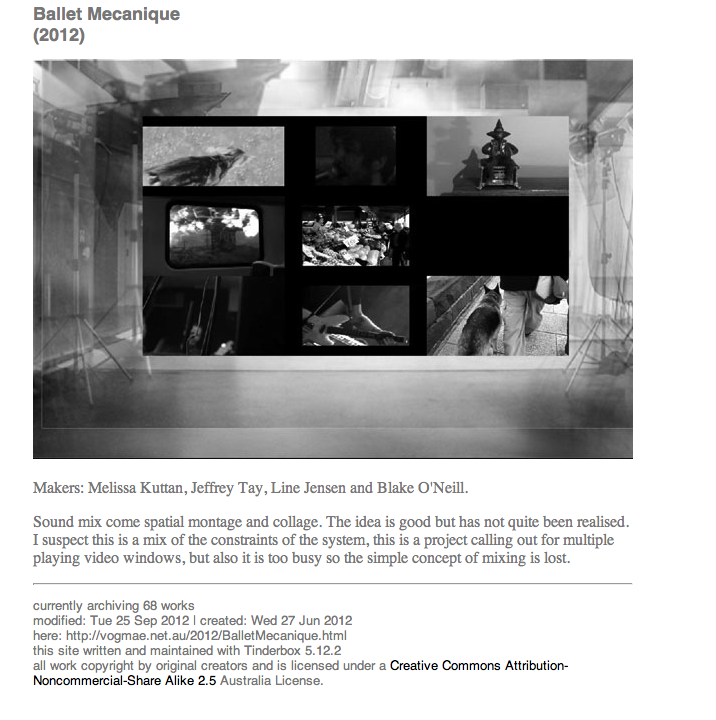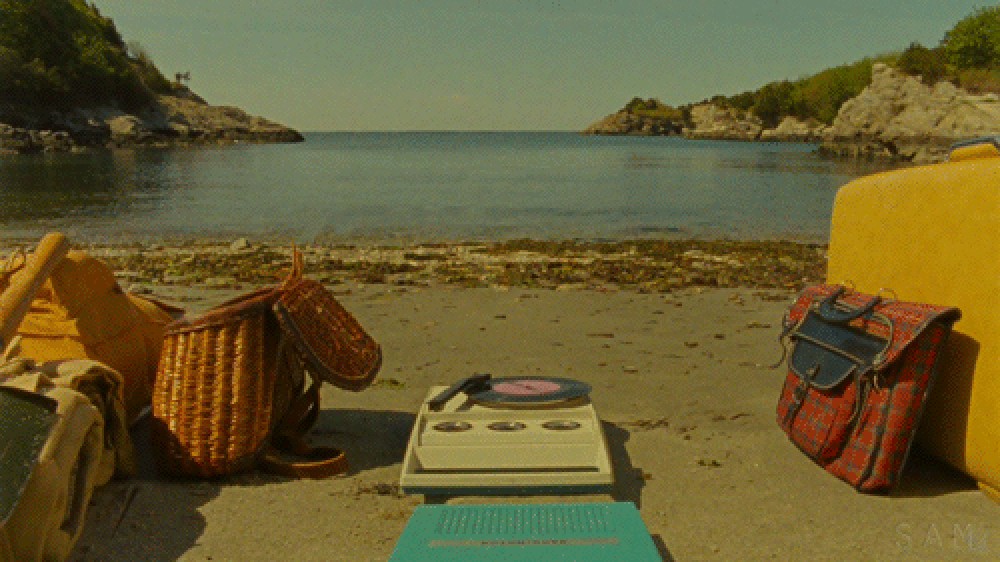Integrated Media 01- Film Essay
The Korsakov programmed project film that I will be talking about is ‘Ballet Mecanique’ (Melissa Kuttan, Jeffrey Tay, Line Jensen, Blake O’Neill, 2012.) It is a collage of clips in a 3×3 set up with only non-diegetic sound used in a way that creates an atmosphere. The film uses audio as a way to demonstrate a pattern as well as relating the content to each other, in which I will discuss further on in this essay.
 This film is a direct homage to the experimental film, ‘Ballet Mecanique’ (Fernand Leger, 1924) obviously in the title, but also in the broken and fragmented pieces of film displayed in the form of a collage, as well as a similar time patterning in the sounds when hovering over the clips. The content is unclear, and is of general surroundings mixed with a few people doing actions or tasks, for example bouncing a ball and pouring a glass of water. Unlike fictional, or staged film the experimental aspect of this film tends to be much more ‘real’ yet in saying this, it is not like documentary in which all is revealed either. I mean this in the sense that the clips do seem to ‘expose’ only a portion of what is happening in the surrounding area.
This film is a direct homage to the experimental film, ‘Ballet Mecanique’ (Fernand Leger, 1924) obviously in the title, but also in the broken and fragmented pieces of film displayed in the form of a collage, as well as a similar time patterning in the sounds when hovering over the clips. The content is unclear, and is of general surroundings mixed with a few people doing actions or tasks, for example bouncing a ball and pouring a glass of water. Unlike fictional, or staged film the experimental aspect of this film tends to be much more ‘real’ yet in saying this, it is not like documentary in which all is revealed either. I mean this in the sense that the clips do seem to ‘expose’ only a portion of what is happening in the surrounding area.
The message of the film is also unclear as the various different clips do not seem to have much correlation between them, in fact it is the use of the percussion instruments playing in similar beats and time that connect them together. By taking away the diegetic sound and creating new sound for the clips, it then changes the meaning and each clip almost become like single members of a percussive orchestra. However with the beats of the sound not completely in rhythm, the idea of experimental film is reinforced, especially with the contrast in clip content and length.
 The interfacing of the film, varied in quality of the actual clips, with some being quite out of focus or poorly exposed and others being very focused and clean or aesthetically pleasing also made the meaning and content unclear as a whole, and I did not determine any composition nor depth in any of the clips that would help make it more clear. There is certainly no general linearity in the narrative as there is no distinct “cause-effect relationship” (Bordwell, D., Thompson, K. p.75) between clips, furthermore establishing this as a take on the original 1924 film.
The interfacing of the film, varied in quality of the actual clips, with some being quite out of focus or poorly exposed and others being very focused and clean or aesthetically pleasing also made the meaning and content unclear as a whole, and I did not determine any composition nor depth in any of the clips that would help make it more clear. There is certainly no general linearity in the narrative as there is no distinct “cause-effect relationship” (Bordwell, D., Thompson, K. p.75) between clips, furthermore establishing this as a take on the original 1924 film.
In terms of genre, this film has the aesthetics of an experimental film, yet the content in each individual clip suggest documentary as it generally un-staged real life, almost observational. With this use of sound, it then adds more to the narrative creating a completely different meaning towards the viewer.

This project film is composed of various clips with the original sound removed and added sound effects, the narrative is non-linear and creates various meanings with the range of content presented. Overall I did enjoy the films aesthetics and use of sound that directly paid homage to the 1924 Fernand Leger film as well as the various meaning that could be interpreted in different ways. Although the quality of the clips were not always high, the relation of the content, pattern and interfacing related to one another and created an interesting film.
References:
- ‘Ballet Mecanique’ (Melissa Kuttan, Jeffrey Tay, Line Jensen, Blake O’Neill, 2012.)
- ‘Ballet Mecanique’ (Fernand Leger, 1924)
- Bordwell, David, and Kristin Thompson. Film Art: An Introduction. New York, N.Y.: McGraw-Hill, 2013. Print.






